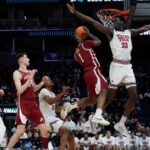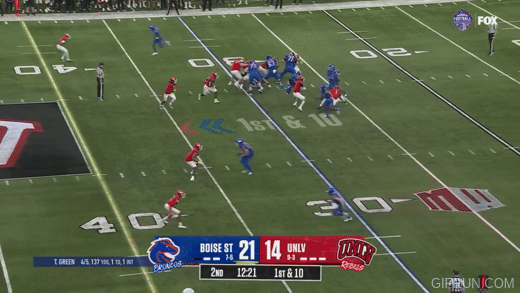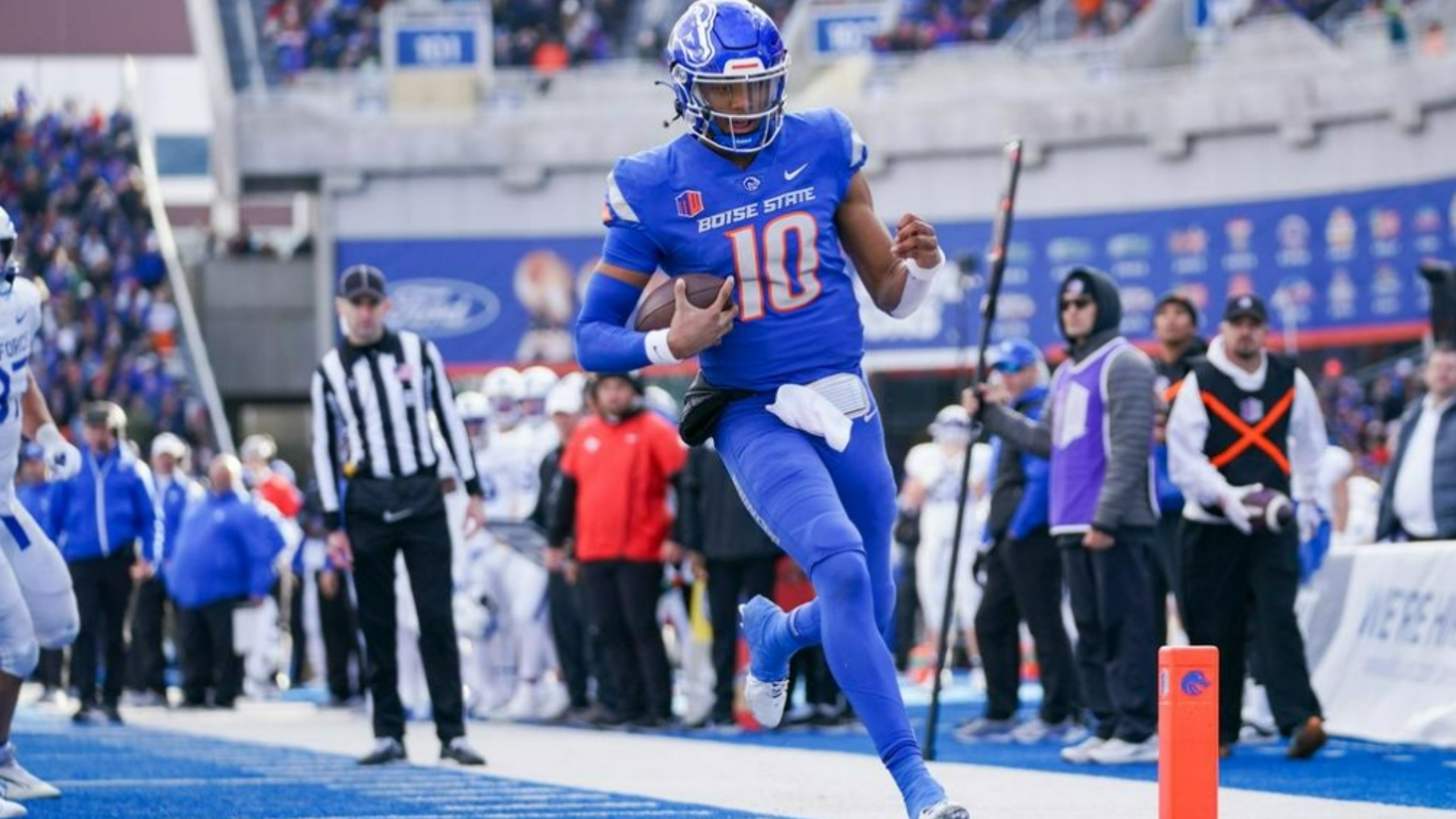Arkansas has its portal quarterback in Boise State transfer Taylen Green, who committed to the Hogs on Monday.
Green just finished his redshirt sophomore season and has two years of eligibility left. He was the 2022 Mountain West freshman of the year and the 2023 MWC championship game MVP. His upside is tremendous, but he’s been a bit inconsistent over his career. Uncertainty regarding his head coach Andy Avalos (who was finally fired midseason this year) probably didn’t help his development. He was benched for a few games this season but won the job back late in the year and played really well as Boise took home the MWC title.
Green is far from guaranteed the 2024 starting job. It’s still unclear if KJ Jefferson will return; this was never likely, and is probably less likely now, and Green will at least be battling with Jacolby Criswell. But new OC Bobby Petrino is going to have some options, at least.
Petrino talked about having an offense he was excited to run, with the broader context of those remarks implying that he didn’t get to run that offense at Texas A&M. The addition of a clear dual-threat quarterback makes it obvious that the offense will probably bear at least some resemblance to what Petrino did at Louisville with Lamar Jackson. Is Green up to the task?
Petrino’s evolution
We went through Petrino’s own schematic evolution both before and since his first Arkansas stop, but here’s a quick refresh as it relates to the signing of Green.
Petrino’s schematic background is the Oneback, the original spread offense, that used three or four wide receivers with wide splits and vertical-stemming routes, forcing the defense to align sideline-to-sideline and cover vertically, thus employing the whole field. There aren’t a ton of screen passes, and things like play-action and max protection, heavily used by both Kendal Briles and Dan Enos, aren’t used as often. Petrino eventually borrowed from other spread innovators like Steve Spurrier to create his own unique scheme that he ran at Arkansas from 2008 to 2011. By the end of his Arkansas time, he was borrowed from the latest spread innovators: the spread-to-run gurus like Gus Malzahn, Rich Rodriguez, and Urban Meyer. This manifested itself in the read-option package Petrino designed for backup QB Brandon Mitchell, but Petrino was fired before he ever had a chance to embrace it fully.
Instead, Petrino went full dual-threat at Louisville, replacing all of his old pro-style run concepts with reads and asking his quarterback to be a threat on every run play. But the pass concepts, which are designed to get receivers wide open with room to work after the catch, continued to be the cornerstone of the offense. Lamar Jackson won the Heisman due largely to his ability to execute Petrino’s passing offense while also being a dangerous runner.
Petrino’s ultimate failure at Louisville (and Missouri State) was primarily due to an awful offensive line. We’ll see in the analysis below, but Louisville’s offensive lines during the Lamar Jackson era were quite a bit worse than even Arkansas’ 2023 line which was pilloried by fans. If Sam Pittman and new OL coach Eric Mateos can deliver a quality line in 2024, that will be the first for Petrino since his last stop in Fayetteville.
- Box Score Breakdown: Texas Tech 85, Arkansas 83

- Matchup Analysis: 3 Texas Tech

- Box Score Breakdown: Arkansas 75, St. John’s 66

A closer look at Taylen Green
Green is 6’6 and 220 pounds. His main strength is his running ability, though his running style is quite different from KJ Jefferson. Green looks a bit more like Matt Jones, with his long strides equating to deceptive speed. Green is extremely difficult to sack, and is dangerous on both designed runs and scrambles. As a passer, Green is a work in progress. He has a very strong arm and Boise had him throwing downfield frequently, but his accuracy is so-so and he throws too many interceptible passes.

The best way to evaluate Green’s game is to compare him to some other quarterbacks. We’re using ProFootballFocus data. I’ll go with KJ Jefferson, Lamar Jackson, and Petrino’s QB at Missouri State, Jason Shelley, as those seem to make the most sense. All, notably, were successful quarterbacks, so if Green can match their success, Arkansas’ offense will be massively improved in 2024. Jackson and Shelley will give us an idea of what kind of patterns we might see in a Petrino offense. We’ll start by tossing in a few other quarterbacks in the portal as well.

Green’s inconsistency is highlighted here. As a passer, he grades the lowest of all these options. But as a runner, he’s behind only Jackson. One thing that will become apparent is that I think Petrino is more interested in Green’s production in 2022 rather than 2023. As you can see, he graded much higher in 2022, and the Broncos entered 2023 in a weird place with Avalos on an extreme hot seat. They looked bad for much of the year, Avalos was fired, then Green played really well under the interim coach and saved his best game for the MWC championship. The profile of his running and passing changed, too, and for the worse. A lot of that started with playcalling.
Green’s 2022 stat profile has some things in common with Jackson’s 2016 and 2017 seasons and Shelley’s 2021 and 2022 years. Let’s dive in, starting with rushing and scrambling.

Jackson’s rushing skill is difficult to top. He ran the ball on almost 20% of Louisville’s snaps over his final two seasons, and averaged an other-worldly nine yards per rush on designed runs (mostly reads). But if you look at Green’s 2022 rushing numbers, they aren’t that far off, just with much lower volume. Green averaged 9.1 yards per non-sack rush, including 13 scrambles for 143 yards and 8.7 yards per rush on designed carries. About 10% of his rushes gained at least 15 yards.
The main place where Green has everyone beat is in avoiding sacks. You can see Jackson and Shelley’s downfall – bad offensive line play – in the fact that Jackson was pressured on 36% and 37% of his dropbacks in his final two seasons, and Shelley at 39% and 41%. That’s an even higher rate than Jefferson the last two years at Arkansas. Jefferson really struggled to avoid sacks during his Razorback career, but his sack-to-pressure ratio ballooned to 33% in 2023, meaning that one-third of pressures against him resulted in a sack, and Jefferson’s scramble rate climbed to 8% of dropbacks. On more than 20% of Jefferson’s dropbacks in 2023, he ended up carrying the football.
Green is very difficult to sack, which will help if Arkansas still struggles to block. Petrino’s schemes are vulnerable to being blitzed into oblivion, so a guy who can evade the rush is a major asset. In 2022, he was sacked on just 6% of his pressures: 293 dropbacks, 83 pressures, only five sacks. And he doesn’t take off on a scramble at a crazy rate, either: in 2022, his scramble-to-pressure ratio was 17%, lower than Jefferson either season (23% and 25%). When pressured, he evades the rush and gets the ball out. You like to see that.

Green is more of a work in progress as a passer, but elements of his passing profile are promising. His raw accuracy is slightly worse than Jackson and notably worse than KJ, but you should note that the throws Boise had him make have a higher degree of difficulty.
Green’s average depth of target (aDOT) is much higher than KJ, and more in line with what we saw from Jackson and Shelley. You can see it in the concept breakdown: fewer screens, more shot plays. Petrino rarely throws screens, and while Green’s screen rate increased in 2023, he was at just 12% in 2022, compared to 18% over Jefferson’s final two seasons. And while KJ threw deep on just 14% of attempts over 2022 and 2023, Jackson was 19% and Green at 18%. Shelley lags those two, but was still ahead of KJ.
Also promising is how quickly Green can get the ball out. In 2022, despite his average pass traveling a full two yards further down the field than KJ, Green needed just 2.96 seconds on average to get the ball out. In 2023, when Boise had him throw a few more screens (but still more shots than KJ, and 1.4 yards more aDOT), he got that down to a lightning-quick 2.72 seconds per pass.
That takes us back to the accuracy, which has some context (more difficult throws), but still needs to improve. Green’s 38% career deep accuracy lags Jackson (41%), Shelley (44%), and KJ (46%), but not horribly. His main issue is midrange accuracy (10 to 20 air yards). His 56% as a freshman was a bit low but fine, but it dropping to 50% in 2023 is bad. He’ll need to get that up: look at Jackson at 67%, KJ at 59%, and Shelley at 58% for their careers.
He’ll also need to get the ball out of harm’s way: he posted turnover-worthy play (TWP) rates of 5% in both seasons, higher than KJ or Jackson in any season. He threw nine interceptions in 2023.
Evaluating this pickup
This is a high-risk, high-reward pickup. If Petrino has another great quarterback development in him, Green has the potential to be an elite player who is a perfect fit for what Arkansas wants. He does a ton of things well: excellent on designed runs, excellent at evading pressure, and capable of getting the ball out quickly and pushing it down the field. Those traits make him a perfect fit for a Power Spread offense.
The accuracy is what has to improve. Without it, the Hogs might can have a decent run game and hit a few big passing plays, but they won’t be able to consistently move the football and drive the secondary back. If Green struggles to consistently find open receivers, then Criswell becomes the better option. The sample size for his career is tiny, but he was 5 of 5 for 75 yards and two touchdowns this season on the midrange throws that Green has not mastered. I expect the ability to move through progressions quickly and deliver on-time, on-target midrange passes will be the biggest point of competition in the offseason.
Thanks for reading! Be sure to follow us on Twitter and on Facebook.
The latest from Fayette Villains, straight to your inbox
Enter your email to subscribe and receive new post alerts and other updates. You can unsubscribe at any time.
